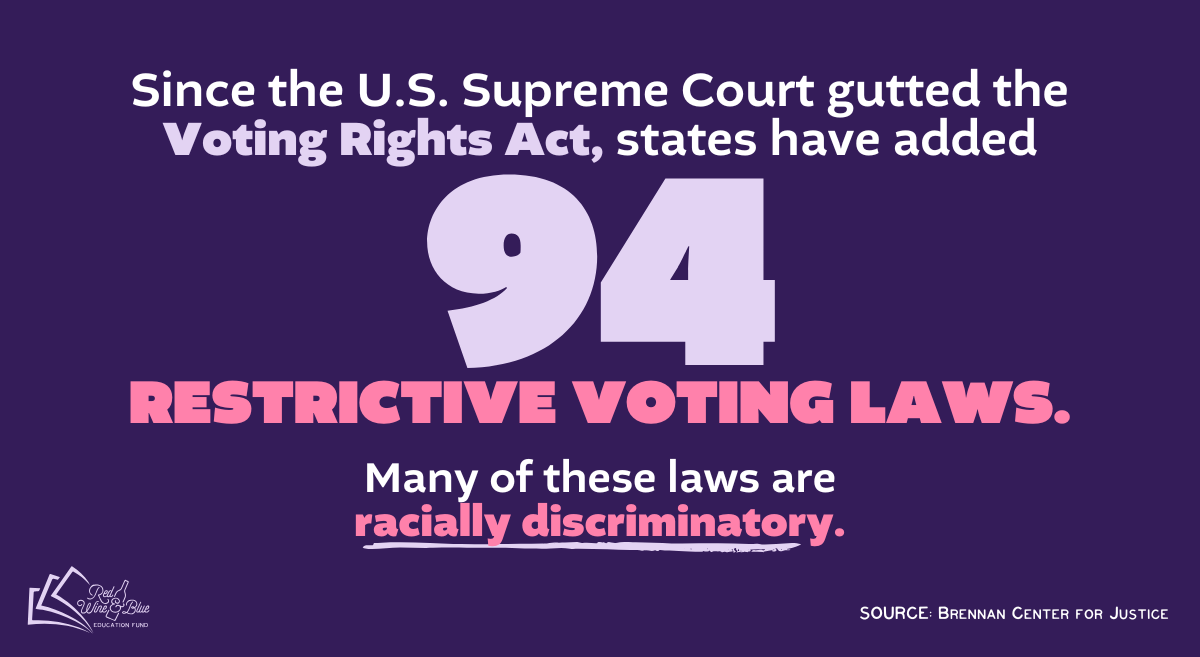The right to vote is one of the most fundamental principles of our democracy, but it hasn’t always been guaranteed for all Americans. And for some of us, it’s still under constant threat. How is that possible? Let’s take a look at the progression of voting rights over time.
A History of Voting Rights and Voter Suppression
When America was founded in 1776, only white, landowning men could vote. Some states further restricted the right to only Christians. In the early 1800s, states began to remove the landowning requirement, allowing more white men to vote.
Black men gained the right to vote in 1870 through the 15th Amendment. But even then, many were not able to exercise that right, because the white people in power put up intentional barriers. They required literacy tests to vote when they knew that Black Americans were educationally disadvantaged, or completely random (and impossible) tests requiring Black voters to guess how many jelly beans were in a jar, or how many bumps were on a cucumber.
They also charged poll taxes — fees for registering and voting — despite Black Americans being economically disadvantaged. White voters were spared by a literal “grandfather clause” that said anyone with a father or grandfather who voted before the abolition of slavery (that is, white men) were excluded from the tax. And there was often intimidation and violence at polling locations from groups like the Ku Klux Klan to keep Black men from voting.
During this time, women were fighting for their voting rights, but white women did not always include Black women in the movement. All women finally gained the right to vote in 1920 through the 19th Amendment.
Progress and Regress
The Civil Rights movement brought about the passing of the 1965 Voting Rights Act, which outlawed those discriminatory literacy tests and other barriers to voting based on race. It also established a rule that the federal government would oversee the passage of any new voting laws in states that had a history of racism. This was known as “preclearance” and was meant to protect people of color from new voter suppression laws — and it worked! It led to an immediate surge of new Black voters in the same year. Unfortunately, the story doesn’t happily end there.
In 2013, the U.S. Supreme Court ended preclearance, ruling in Shelby County v. Holder that it was unconstitutional. This meant that the states with a history of discrimination could oversee their own voting laws again. Almost immediately, states began to introduce new, restrictive voter laws.
Modern Day Voter Suppression
According to the Brennan Center for Justice, since Shelby, 29 states have passed 94 new laws making it harder for people to vote. At least 1/3 of those laws likely would’ve been prevented by federal preclearance under the Voting Rights Act if it still existed. And the gap in turnout rates between white voters and voters of color has grown since the decision.
After the 2020 election, 440 voter restriction bills were introduced nationwide. This included a wave of bills targeting mail-in voting, mainly because its growth during the Covid-19 pandemic led to an increase in voter turnout. In 2023 alone, 356 restrictive voting bills were introduced.
Why does this voter suppression persist? For the same reason it started 250 years ago — the white, Christian men in power want to stay in power and they are afraid that they won’t win elections if there is an increase in more diverse voters. Far-right extremist legislators in districts and states with high populations of voters of color are the ones pushing the hardest for more restrictive voter laws.
What do restrictive voter laws and voter suppression actually look like?
Here are just some examples:
- Laws requiring an approved voter ID (that can be costly and harder for some groups to get).
- Laws restricting and criminalizing voter assistance (like making it a crime to hand out snacks or water to voters waiting in line).
- Putting restrictions on who can hold voter registration drives, and how they’re run.
- Limiting voter registration periods, early voting periods, or polling locations.
- Ending or restricting mail-in voting.
- Purging voter rolls, especially without informing purged voters.
- Unfair drawing of voting districts to favor a certain party (aka gerrymandering).
According to the Brennan Center and the ACLU, these types of laws disproportionately keep Black and brown people from voting. These are usually state laws, but we’re also currently facing federal attempts to suppress voters.
Donald Trump just issued a sweeping Executive Order to take more control over elections and to implement a highly restrictive voter ID requirement nationwide. At the same time, MAGA extremists in Congress are trying to pass the SAVE Act, which has a similarly restrictive ID requirement. These efforts could take away voting rights from tens of thousands of married women, immigrants, transgender people, and new voters.
What Can We Do?
We can all agree that we want safe and fair elections, but passing extremely restrictive voter laws is not how we ensure that. Everyone should be able to vote. In the coming weeks, we’ll dig deeper into what we can do to fight voter suppression and ensure voting rights for all.


